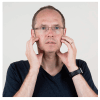An Algorithm for Jaw Pain among Divers
- PMID: 38892877
- PMCID: PMC11173261
- DOI: 10.3390/jcm13113167
An Algorithm for Jaw Pain among Divers
Abstract
Background: Temporomandibular disease (TMD) is commonly seen, and divers also experience pain in the temporomandibular joint (TMJ) or masticatory muscles. This article aims to provide a tool for diving physicians or medical professionals involved in diving medicine since jaw pain among divers is a pertinent subject and can be challenging to evaluate without some background in dentistry or maxillofacial surgery. Method: A basic algorithm was developed to provide a tool to differentiate jaw pains experienced by divers. Three brief case studies were developed, and five diving physicians were tasked with diagnosing the cases using the algorithm. Additionally, simple exercises and massage techniques that can benefit patients with TMD, particularly immediately after diving, are outlined. Results: All five diving physicians successfully diagnosed the cases using the algorithm. However, three of them were unable to diagnose the first case (disc luxation) without consulting the algorithm. Nevertheless, all physicians acknowledged the utility of the algorithm. Conclusions: Jaw pain in divers can stem from diverse causes, but effective treatment options exist. Our study findings provide valuable insights to assist diving physicians in making accurate diagnoses and guiding appropriate patient management, which may include referrals to specialists such as dentists, maxillofacial surgeons, or orthodontists.
Keywords: decompression sickness; diving; masticatory muscles; osteoarthritis; pain; temporomandibular joint.
Conflict of interest statement
The authors declare no conflicts of interests.
Figures







Similar articles
-
Incidence of dental barotrauma and temporomandibular joint problems of divers in Turkey.Undersea Hyperb Med. 2023 Second Quarter;50(2):95-104. doi: 10.22462/01.01.2023.39. Undersea Hyperb Med. 2023. PMID: 37302074
-
Temporomandibular disorders in scuba divers-an increased risk during diving certification training.J Craniofac Surg. 2012 Nov;23(6):1825-9. doi: 10.1097/SCS.0b013e3182710577. J Craniofac Surg. 2012. PMID: 23147349
-
Oral and maxillofacial aspects of diving medicine.Mil Med. 2004 Feb;169(2):137-41. doi: 10.7205/milmed.169.2.137. Mil Med. 2004. PMID: 15040636
-
"Multidisciplinary management of post- infective osteoarthritis and secondary condylar resorption of temporomandibular joint: a case report in a 9 years-old female patient and a review of literature".Ital J Pediatr. 2022 May 3;48(1):62. doi: 10.1186/s13052-022-01255-0. Ital J Pediatr. 2022. PMID: 35505365 Free PMC article. Review.
-
Reported concepts for the treatment modalities and pain management of temporomandibular disorders.J Headache Pain. 2015;16:106. doi: 10.1186/s10194-015-0586-5. Epub 2015 Dec 7. J Headache Pain. 2015. PMID: 26644030 Free PMC article. Review.
Cited by
-
Diving into discomfort: orofacial pain dynamic-A systematic review.Front Public Health. 2025 May 9;13:1553541. doi: 10.3389/fpubh.2025.1553541. eCollection 2025. Front Public Health. 2025. PMID: 40416680 Free PMC article.
References
-
- Gempp E., Blatteau J.E., Simon O., Stephant E. Musculoskeletal decompression sickness and risk of dysbaric osteonecrosis in recreational divers. Diving Hyperb. Med. 2009;39:200–204. - PubMed
-
- Rudge F.W. Decompression sickness affecting the temporomandibular joint. Aviat. Space Environ. Med. 1990;61:1139–1140. - PubMed
-
- Newton J.P., Hobson R.S., Sturrock K.C. The design and construction of customised mouthpieces for subaqua diving. Eur. J. Prosthodont. Restor. Dent. 1995;3:223–226. - PubMed
LinkOut - more resources
Full Text Sources

